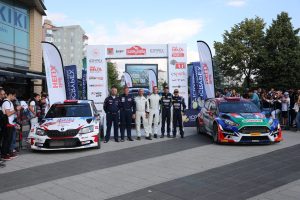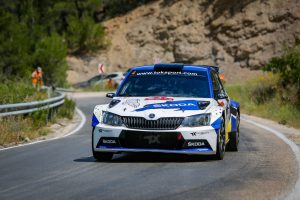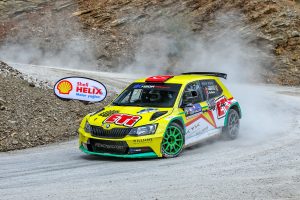[:tr]
0 numara: Yarışmacılar start almadan önce etabı geçen ve seyircileri uyaran öncü araçtır.
Aerodinamik parçalar: Ralli otomobillerini yüksek süratlerde yolda tutmaya yardımcı olan ve motoru, vites kutusunu frenleri soğutmak için otomobilde üzerinde kullanılan spoiler, tamponlar ve şekil verilmiş diğer panelleri ifade eder.
ALS: Anti Lag Sisteminin (turbo gecikmesinin önlenmesini sağlayan sistem) kısaltılmış hali.
Aktif diferansiyel: Dört çeker ralli otomobillerinde kullanılan ve en iyi yol tutuşu sağlamak için hangi tekerleğe ne kadar gücün gönderileceğini denetleyen bilgisayar destekli diferansiyel sistemi. 2006 yılından itibaren aktif ön ve arka diferansiyeller yasaklanarak yerine mekanik olarak ayarlanan sistem getirildi.
Amortisör: Ralli otomobili süspansiyonunun temel parçalarından biridir. Her otomobil, her tekerleğin göbeğine bağlanan 4 amortisöre sahiptir. Amortisörler zemin üzerindeki tümsekleri absorbe ederek, otomobilin mümkün olduğunca yerle temas etmesini sağlayacak biçimde tasarlanmıştır.
Amortisör ayarları: Ralli otomobilinin amortisörleri ayarlanabilir elemanlardır. Böylelikle farklı karakteristikler için uygun hale getirilir. En basit anlamda amortisörlerin sertliği, esnekliği ve yüksekliği ayarlanabilir. Pilotlar etaplar arasında bu ayarları yaparken genellikle sistem üzerindeki ayar elemanlarını kullanırlar. Değişikliklerin ölçütü olarak ise genellikle “tık” ibaresi kullanılır. (1 tık=1 birim).
Co-pilot (Yardımcı sürücü): Yaklaşan yol koşulları hakkında pilota sözlü bilgi veren, yol tariflerini açıklayan ve ön yolcu koltuğunda oturan sporcu.
Deneme Sürüşü: Ralli başlamadan önce rallinin genel karakteriyle benzer özellikteki parkurda koşulan ve ekiplere otomobillerini kontrol etme fırsatı tanıyan seanstır.
Etaplar: Pilot ve co-pilotun mümkün olan en kısa sürede geçmeye çalıştıkları, özel etap olarak da adlandırılan rallinin yarışılan kısımlarını ifade eder.
Etap zamanı: Bir özel etabın startından bitiş noktasına kadar kaydedilen zamanı belirtir.
FIA: Uluslar arası Otomobil Federasyonu. Cenevre’de bulunan ve Dünya Ralli Şampiyonası ve diğer motor sporları aktivitelerinin yönetici organıdır.
Flying finish (FF noktası): Bir özel etabın bittiğini, zaman alımının durduğu noktayı ifade eder. Bu şekilde adlandırılmasının sebebi otomobillerin bu noktayı tam gaz geçmeleridir.
Gün: Dünya Ralli Şampiyonası organizasyonlarında bir gün içinde koşulan etapların tümünü ifade etmek için kullanılır.
HANS aygıtı: Baş ve Boyun Desteği’nin kısaltılmış halidir. Boynun arkasından omuzlara takılır ve bir kaza durumunda pilotun boynunun istem dışı hareketlerini kısıtlayarak ciddi yaralanmaların önüne geçer.
Interkom: Araç içindeki motor gürültüsünden etkilenmeden pilot ve co-pilotun iletişim kurabilmesi için kullanılan telsiz bağlantısıdır. İnterkom kulaklıkları ve mikrofonları kaska içine entegre edilmiştir.
Hedef süre: Organizatör tarafından bir ralli otomobiline normal etabı tamamlaması için izin verilen süredir. Eğer yarışmacı kontrol noktasına hedef süreden daha erken ya da daha geç gelirse zaman cezaları uygulanır.
İşletme şaftı: Motordan ön ya da arka diferansiyele gelen gücü tekerleklere aktaran transmisyonun parçalarıdır. Her ralli otomobilde 4 adet bulunur.
Kalkış kontrol sistemi: Sürücüye durarak start esnasında mümkün olan en iyi startı alması için yardımcı olan sistemdir. Ayrıca motorun stop etmesini önleyen bir cihaz içerir.
Kapalı Park: Belirli kurallara tabi olan ve tüm yarışan otomobillerin akşam tutulduğu güvenli alandır.
Karter muhafazası: Motor altında yer alan ve yağ karteri ile vites kutusunu darbelere karşı koruyan dayanıklı panel.
Keşif: Her ralliden önce yarışmacılar etapları tanımak için iki gün antrenman yapma şansına sahiptirler. Bu keşif esnasında otomobiller organizatör tarafından belirlenen maksimum 50-70 km arasında değişen hız limitine uymak zorundadırlar. Yarışmacıların etaba alışmak ve yol notu çıkarmak için her etabı iki kez geçme hakları vardır.
Keşif otomobili: Pilot ve co-pilotun ralliden önce güzergâhı tanımak ve yol notu hazırlamak için kullandıkları yüksek standartlı yol otomobilidir.
Kısıtlayıcı: FIA kurallarının ralli motorları için gerektirdiği şekilde motor gücünü 300 beygir civarında tutabilmek için hava/yakıt karışımının akışı 34 mm çapındaki subap vasıtasıyla sağlanır. Eğer böyle bir kısıtlama söz konusu olmasa otomobiller 500 beygirden daha fazla güç üretir.
Normal Etap: Özel etaplar, servis alanı ve kapalı park arasında yer alan trafiğe açık yollardır. Sürücüler uygulanmakta olan trafik kurallarını uymalıdırlar.
Öncü araçlar: Yarışmacılardan önce etapları geçerek hava ve yol şartları gibi bilgileri rapor eden, organizasyonun güvenlik araçlardır.
Özel Seyirci Etabı: Ralli pilotlarının birbirlerine karşı yarıştığı, genelde şehir içindeki mekanlarda düzenlenen ve iki paralel yoldan oluşan parkurdur.
Podyum Rampası: Rallinin resmi start ve bitişlerinde, start alan ve yarışı tamamlan tüm otomobillerin geçmesi gereken yüksek platformdur.
Raya oturmak: Sürücünün iyi bir viraj dönüş hızı için otomobili ile viraj içinde kalan ve geçen otomobiller tarafından oluşturulan derin iz üzerinden geçmesidir.
Roll cage: Bir darbe ya da takla atma durumunda pilot ve co-pilotu korumak için tasarlanmış karbon çelik borulardan oluşan kafes yapısıdır.
Servis Alanı: Zaman limitlerine bağlı kalınarak otomobillerin bakımlarının ve tamiratlarının yapılması için tasarlanmış yerdir.
Sıralama: Sürücülerin geçmiş rallilerdeki başarıları göz önünde tutularak hangi pilotun hangi sırada start alacağının, yarışma numarasının belirlenmesidir.
Sıralı vites kutusu: Vites artırırken ya da düşürürken viteslerin sırayla (1-2-3-4-5-6) değişmesini sağlayan sistemdir. Çoğu WRC vites kutusu yarı otomatiktir ve gazı, debriyajı, vites değişimini yöneten elektro-hidrolik kontrol mekanizmasıyla donatılmıştır.
Start listesi: Yarışmacıların hangi sıra ile start alacağını belirten listedir. Rallinin her gününde start listesi farklıdır. Açılış gününün start listesi sürücüler klasmanının dizilişine göre düzenlenir; şampiyonada lider olan sürücü ilk sırada start alır. İkinci ve üçüncü gün için ise yarışmacılar toplam etap zamanları dikkate alınır; rallide lider olan ekip ilk sırada start alır.
Stop noktası: Yarışmacının özel etap sonrasında durup etap derecesini karnesine yazdırdığı, flying finish noktasından 200-250 m sonra olan noktadır
Sürücü güvenliği: : Ralli otomobillerinde hava yastığı yoktur. Bunun yerine sürücü ve yardımcı sürücü koruyucu kafes içinde oturur ve 6 noktalı emniyet kemerleriyle kendilerini sabitlerler. Otomobilde, gerektiğinde otomatik olarak devreye giren yangın söndürme sistemi vardır ve ekip ateşe dayanıklı tulum, kask ve başı ve boynu darbelerden etkilenmesini önlemek için kullanılan HANS’ı kullanırlar
Teknik Kontrol: Yarıştan önce, yarış esnasında ve yarıştan sonra ralli otomobillerinin kurallara uygunluğunu kontrol eden teknik görevlilerin yaptığı kontrollerdir.
Toprak zemin ayarları: Gevşek zeminli etaplarda ralli otomobiline maksimum performansı sağlayacak lastik seçimi ve süspansiyon ayarlarını ifade eder.
Turboşarjör: Motorun daha fazla güç üretmesi için yakıt/hava karışımının basıncını arttıran türbindir. Tüm ralli otomobillerinde normal yol otomobillerinden 4-5 kat daha fazla basınç sağlayan turboşarjör (turbo) kullanılır. Anti lag sistemi (turbo gecikmesinin önlenmesini sağlayan sistem) sayesinde ralli otomobillerinin çoğu düşük devirlerde bile maksimum turbo performansını verebilir.
Yarış kıyafeti: Ralli sporcuları ateşe dayanıklı 3 kat tabaka içeren yarış kıyafeti kullanırlar. Buna ek olarak aleve dayanıklı iç çamaşırı ve kasklarının içine ateşe dayanıklı başlık (balaklava) giyerler.
Yol Notu: Co-pilot tarafından yaklaşan yol şartlarını pilota aktarmak için kullanılan talimatlardır. Yol notları her ralli öncesinde gerçekleştirilen keşif sürüşleriyle hazırlanır. Bu sürüşlerde pilot etabı geçerken kendi anlayabileceği şekilde co-pilotuna yol notuna ne yazması gerektiğini söyler. Co-pilot da de bunları kısaltarak yazar. Ralli esnasında ise co-pilot bu notları pilota okur.
Yol Tarifi: Ralli organizatörü tarafından hazırlanan ve tüm yarışmacılara dağıtılan içinde talimatlar, zaman çizelgeleri, yönler, güzergâhlar ve haritalar bulunan özel kitaptır.
Zaman Aşımı Limiti (OTL): Over time limit’in kısaltılmış halidir. Yarışmacı zaman kontrol noktasına veya servis alanına 15 dakikadan geç gelirse ya da ralli esnasında toplamda 30 dakikadan daha fazla geç gelirse zaman limitini aşmış olur ve o günün klasmanına giremez.
Zaman cezası: Etap startı, servis girişi ve servis çıkışı fark etmez, zaman kontrol noktasına gelinen her 1 dakikalık gecikme için ekibe 10 saniye zaman cezası verilir. Zaman kontrol noktasına erken gelinen her dakika içinse 1 dakika zaman cezası verilir.
Zaman karnesi: Co-pilot tarafından muhafaza edilen ve tüm ralli boyunca etap zamanlarının üzerine işlendiği belgedir. Herhangi bir karışıklık durumunda karneye başvurulması adına önemlidir ve organizasyon görevlileri tarafından imzalanarak geri verilir.
Zaman kontrol noktası: Otomobillerin durup ralli görevlilerine noktaya resmi varış saatlerini işlettikleri yerdir.[:en]
ALS: Short form for Anti Lag System.
Active differential: The centre differential on a four wheel drive WRC car that uses computer input to send power to the wheels with the best grip, to maximise performance. From 2006 active front and rear differentials were banned and are instead mechanically operated.
Aerodynamics: Rally cars have spoilers, splitters and other shaped panels on the bodywork to direct cool air past the engine, gearbox and brakes and help keep the car firmly on the road – or flying level – at high speeds.
Co-driver: The navigator in the front passenger seat who gives a running commentary to the driver about road conditions ahead.
Dampers: An essential part of a rally car’s suspension. Each car has four – one connected to each wheel hub. Dampers are designed to absorb bumps from the road and keep the tyre in contact with the surface often as possible.
Damper settings: Rally car dampers are adjustable so they provide different characteristics. At the simplest level they can be soft or hard, but other settings like the amount of rebound or ride height can also be altered. Drivers often adjust their damper settings between stages by turning adjustment wheels on the units. The degree of change is usually measured in ‘clicks’ of the adjuster.
Ditch-hooking: When drivers drive a trail with their inside front wheel over a road-side ditch.
Drive shaft: The part of the transmission system which transfers drive from the front or rear differential to the wheel. Each rally car has four.
Driver safety: Rally cars don’t have airbags. Instead, the crew sit inside a protective roll cage and strap themselves in with six-point wide-strap safety belts. The car has an automatic fire extinguisher system plumbed-in and the crew wear flameproof overalls, safety helmets and a head and neck support system (see Hans device).
ERC: Short form for The FIA European Rally Championship.
FIA: The Federation Internationale de l’Automobile, the Geneva-based governing body for world-wide motor sport which regulates and controls the World Rally Championship.
Flying finish: A flying finish marks the end of a stage – so called because the cars ‘fly’ across it at full speed.
Gravel cars: (Also gravel crew) Cars which are driven through stages ahead of the competitors to report back on weather and surface conditions.
Gravel settings: The choice of tyres and suspension adjustments to give a WRC car maximum performance on a loose surfaced stage.
HANS device: HANS stands for head and neck support. Worn on the shoulders and around the back of the neck, in the event of an accident, the HANS device reduces the amount the head can move can help protect a driver’s head and neck from serious injury.
Intercom: The audio link that enables the driver to hear the co-driver’s instructions above the noise of the engine. Intercom headphones and a microphone are built into the safety helmet.
Launch control: This helps the driver to make the fastest getaway from a standing start. The system has a device that prevents the engine stalling.
Leg: Term to describe a day’s rallying over several stages of the World Rally Championship event
OTL: Over time limit. Competitors arriving more than 15 minutes late at a time control or service area, or who are more than 30 minutes late in total during the rally, are OTL and retire from the day’s competition.
Pace notes: A description of the road ahead, called out by the co-driver to inform the driver of what is coming up. Pace notes for every rally are made during the pre-event reconnaissance. As they recce each stage, drivers describe the road to their co-drivers, who write down the information in a form of shorthand. During the rally the co-driver reads the notes back to the driver.
Parc ferme: The secure area where all competing rally cars are kept overnight.
Podium Ramp: Raised platform at the official start and finish of the rally, over which the competitors must drive their cars.
Race suit: Rally crews wear racing overalls containing three layers of flameproof material, plus flameproof underwear and a flameproof balaclava under their helmet. They get quite hot when the temperature reaches 40 degrees in Greece…
Recce car: A largely standard road car which the driver and co-driver use to reconnoitre the route before the rally starts and prepare pace notes.
Recce: Before every rally, drivers and co-drivers spend two days reconnoitring the route at a maximum speed (set by rally organisers) of between 50 and 70kph. Crews are allowed two passes through each stage to familiarise themselves with the route and make pace notes.
Restrictor: To limit engine output to around 300bhp, the FIA requires all WRC specification engines to be fitted with a 34mm diameter inlet restrictor which limits the flow of fuel/air mixture to the combustion chambers. Without a restrictor engines would produce more than 500bhp.
Road book: A specially prepared book of instruction, timings, directions and maps issued to each crew by the rally organiser
Road section: A public road which links the special stages, service points and parc ferme. Drivers must obey all applicable traffic laws on road sections.
Roll cage: A structure of high carbon steel tubes welded inside the passenger compartment designed to keep the driver and co-driver safe in an impact or roll-over.
Running order: The order in which competitors tackle the stages. The running order (also called the start order) is different for each day of the rally. The order for the opening day is determined by the drivers’ championship standings – with the leader going first. For days two and three, entrants tackle the stages in rally leading order – with the leader going first.
Scrutineers: Technical officials who check the legality of the rally cars before, during and after the event.
Seeding: The order in which drivers start each rally, determined by their success in past rallies.
Sequential gearbox: An arrangement in which the gear lever or paddle selects each gear in turn (1-2-3-4-5-6) when changing up and vice-versa when changing down. Most WRC gearboxes are semi-automatic and have an electro-hydraulic control mechanism which manages the throttle, clutch and gear change.
Service park: A designated area where checks, maintenance and running repairs can be made to the rally cars, subject to strict time limits.
Shakedown: The opportunity for crews to check their competition cars, on terrain similar to the rally, just before the event starts.
Stages: The competitive sections of the rally, also called special stages, where drivers and co-drivers drive as fast as they can to achieve the shortest time.
Stage time: The time recorded from the standing start of a stage to the flying finish.
Stop control: A point 200-500 metres past the flying finish where the car must stop to have its time recorded.
Studs: Metal spikes fitted to the treads of winter tyres to give grip on snow and ice.
Sump Guard: A reinforced panel under the car’s engine bay to protect the engine’s sump (the oil reservoir) and transmission.
Super Special stage: A stage – often set up in a sports stadium – with two parallel tracks that enable a pair of rally drivers to race each other.
Target time: The official time allowed by rally organisers for a rally car to complete a non-competitive road section. Time penalties are applied if competitors check-in earlier or later than the target time.
Time card: Carried by the co-driver, the time card is a record of stage times and time control arrival times throughout the rally. The card is stamped by event officials as the rally progresses and provides proof of a competitor’s whereabouts in case of a dispute.
Time control: The place where cars must stop to get an official passing time recorded by rally officials
Time penalty: Rally crews are penalised 10 seconds for every minute the car is late to a time control – whether that is a stage start, service-in control, service-out control. Checking in early to a time control carries a stiffer penalty of one minute for every minute early.
Turbocharger: An exhaust-driven turbine that pressurises the fuel/air mixture into the engine to enable it to develop more power. Some rally cars use turbochargers (turbos) which develop 4-5 times the pressure of the turbo on a road car. Thanks to a system called anti-lag, most WRC cars are able to produce maximum turbo boost even at low engine speeds.
WRC: Short form for The World Rally Championship.
Zero car: A course car driven through a stage before the competitors start it to alert spectators that the section is live.[:]







